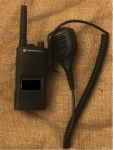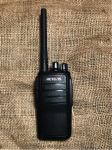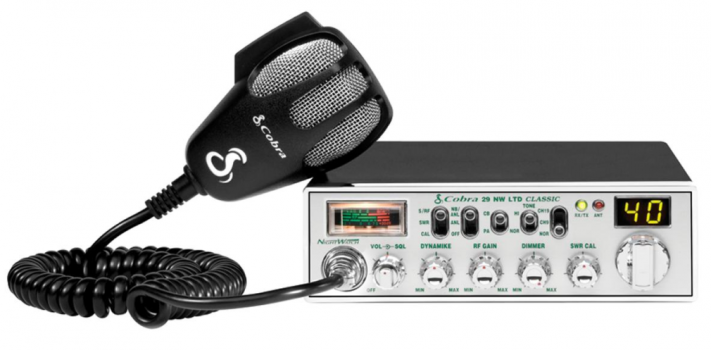(Continued form Part 2.)
General Mobile Radio Service (GMRS)
GMRS is a personal radio service that uses the same frequencies and channels as FRS, but more power is allowed, and there are greater equipment options. The FCC defines GMRS as “A mobile two-way voice communication service, with limited data applications, for facilitating activities of individual licensees and their family members, including, but not limited to, voluntary provision of assistance to the public during emergencies and natural disasters.” 47 CFR 95.1703. Note that unlike FRS or CB, GMRS requires a license. 47 CFR 95.1705. There is no test, and the license covers you and your immediate family. It costs $70 for 10 years, and you will be assigned a call sign. GMRS stations are required to identify themselves by their call signs at the end of each transmission and periodically during transmissions. 47 CFR 95.1751. Many people operate on GMRS without a license, but doing so is illegal.
In addition to blister-pack type handhelds, it is legal to operate mobile, fixed, and base station radios as well as repeaters on a subset of the GMRS frequencies. GMRS covers all 22 of the FRS channels, and there are an additional 8 GMRS channels available that are exclusive to GMRS: 467.5500, 467.5750, 467.6000, 467.6250, 467.6500, 467.6750, 467.7000, and 467.7250. 47 CFR 95.1763. These additional channels are, however, reserved for use by fixed GMRS stations and stations using repeaters, so they are not useful for simple communication between handheld radios. For use between handheld radios, the frequencies are the same for FRS and GMRS.
Transmitters must be certified by the FCC to be legal on GMRS, and the rules expressly provide that if a transmitter has the capabilities to operate in the amateur radio service it can’t be GMRS certified. 47 CFR 95.1761 (c). This means you cannot use a Baofeng UV5R for GMRS (or FRS) without breaking the law.
The power limits for GMRS vary depending on which channel you are on. It can be up to 50 watts for some channels and is limited to 0.5 watts for others. 47 CFR 95.1767.
For most people, GMRS probably does not do much for them that FRS won’t, and most folks won’t go to the trouble to apply for the license. You do have the option of running mobile units and even a repeater, but there is a paucity of equipment available for such use that is certified, and it is expensive. Based on an Internet search, Midland offers the MicroMobile MXT400, which is GMRS 40 watt radio that can be used as a base station or in a vehicle. You would also need a suitable antenna, and if you want to use it as a base station you would also need some sort of power supply or deep cycle battery to power it.
GMRS can be a viable option for a family or prepper group if you are willing to 1) get the license, and 2) put together a system suitable to your location, which could include a repeater and one or more base or mobile units. This is going to take a bit of work and expertise, but it might be a good option if you have the interest. FM over UHF is inherently a short-range technology though, no matter if you are running 0.5 or 50 watts.
An Explanation of “Privacy Codes”
Handheld radios designed for FRS or GMRS invariably come equipped with “privacy codes.” This term is deceptive, and it is important for preppers and others who might use these radios for serious purposes to understand how this feature works and what it does.
First, FRS and GMRS transmissions are all unencrypted. They are generally limited to FM voice communications, and it is illegal to modify one to send encrypted signals. You can of course talk in code (e.g. “please meet me at rally point bravo 3”), but that is a matter of operating not technology.
When you select a “privacy code” on an FRS or GMRS radio, what you are really doing is telling the radio to do two things: 1) transmit a sub-audible tone in the background whenever you have the transmitter keyed up, and 2) only break squelch and play received signals that have that same sub-audible tone in the background. This can be a useful feature if there are others nearby using the same channel, as it will prevent you from having to listen to their conversations. When they are transmitting, you just won’t hear them, even if your radio is receiving a strong signal. Of course, if someone else is transmitting on the same channel you are trying to use, you won’t be able effectively use it at the same time, which limits the utility. It is important to understand, however, that selecting a “privacy code” does nothing to prevent others from hearing your transmissions. The other user could choose to select a different “privacy code” from yours, in which case he won’t hear your transmissions, but if he either selects no code or the same one you chose, then he’ll hear your transmissions as long as he is in range. This is why calling them “privacy codes” is terribly misleading—they really do nothing to protect your privacy.
A better term is perhaps interference eliminator codes, but even that is wrong because as mentioned above if someone else is using the channel nearby it will interfere with your signals whether you have it blocked out with a code or not. The FCC rules say simply that it is permissible to transmit “subaudible tones or other signals for the purpose of selective calling and/or receiver squelch activation.” 47 CFR 95.377. That is pretty clear.
My suggestion is to leave these tones turned off on your FRS and GMRS radios. If you are getting interference, just switch to a different channel. The codes can be useful if your radios are breaking squelch from distant signals not strong enough to interfere with your intended communications. Under those circumstances, the feature can operate as intended to eliminate the nuisance of having to listen to a bunch of static.
Multi-Use Radio Service (MURS)
In 2000, the FCC created the multi-use radio service (MURS). MURS is a VHF radio service with five defined channels. It is designed for and popular with business users, and I understand construction companies are among its most common users.
Like FRS and CB, MURS is “licensed by rule,” so there is no need for an individual license. And there is no requirement to transmit station identification. The five MURS channels are 151.820, 151.880, 151.940, 154.570, and 154.600 MHz. 47 CFR 95.2763. MURS radios are allowed to transmit sub-audible tones to control squelch, much like the “privacy codes” on FRS and GMRS units (more on this below).
MURS transmitters must be certified by the FCC. 47 CFR 2761. They are allowed 2 watts of power. 47 CFR 95.2767. They are permitted to have external antennas which can be up to 60 feet above the ground. 47 CFR 95.2741.
I personally find MURS to be excellent for several reasons. First, it is VHF, rather than UHF, so all else being equal you can get more range for the same power and antenna type. If you are operating in a building or at very short range this may not matter, but it gives you options. More importantly, MURS seems to have far fewer users than FRS, GMRS, or CB. There are not many radios available that are certified for MURS, and the ones that are out there are more expensive than FRS or GMRS units. I have certainly observed people using modified amateur radio equipment (or unmodified Baofengs) to transmit on MURS, but this is illegal absent an actual emergency. Finally, the MURS radios that are out there tend to be high quality with robust construction, quality, long-lasting batteries, and well-designed accessories. They are built for professional use.
 I have used the Motorola RMM-2050 MURS radio in several different applications to very good effect. We use them with headsets for our church security team, and some like-minded friends and I also have some we use for road trips, hunting, and training. I think for a prepper group, this is the best choice for most people. The radios are extremely easy to use. You just turn the power knob, which also controls the volume. The radio will then announce its battery level and which of the five channels it is on. In actual use I have almost never heard any other users on MURS. Motorola seems to maintain a minimum retail price of $189 each for these radios, and I have not seen them offered at a discount other than used on eBay.
I have used the Motorola RMM-2050 MURS radio in several different applications to very good effect. We use them with headsets for our church security team, and some like-minded friends and I also have some we use for road trips, hunting, and training. I think for a prepper group, this is the best choice for most people. The radios are extremely easy to use. You just turn the power knob, which also controls the volume. The radio will then announce its battery level and which of the five channels it is on. In actual use I have almost never heard any other users on MURS. Motorola seems to maintain a minimum retail price of $189 each for these radios, and I have not seen them offered at a discount other than used on eBay.
Public-safety style speaker-mics are available from Motorola for an additional $49 if that suits your application. I’m sure some readers will balk at the cost, but that is actually a pretty modest price for a professional quality radio. I do not want to trust my life or the lives of my family and friends to a $25 radio.
 A couple of details about the RMM-2050 that readers may find useful. First, the channels are out of order. Most people number the MURS channels in the order they appear in the FCC rules, with 151.820 being thought of as channel 1. On the RMM-2050 they are in a different order with channel 1 being 154.570, channel 2 being 154.600, channel 3 being 151.820, channel 4 being 151.880, and channel 5 being 151.940. The other thing to know if you intend to use the RMM-2050 to communicate with other MURS radios is that it comes programmed to use CTCSS codes for squelch. This works just like the “privacy codes” described above. CTCSS stands for Continuous Tone Coded Squelch System. It is a standard set of sub-audible tones commonly used on amateur, public safety, and land mobile radios.
A couple of details about the RMM-2050 that readers may find useful. First, the channels are out of order. Most people number the MURS channels in the order they appear in the FCC rules, with 151.820 being thought of as channel 1. On the RMM-2050 they are in a different order with channel 1 being 154.570, channel 2 being 154.600, channel 3 being 151.820, channel 4 being 151.880, and channel 5 being 151.940. The other thing to know if you intend to use the RMM-2050 to communicate with other MURS radios is that it comes programmed to use CTCSS codes for squelch. This works just like the “privacy codes” described above. CTCSS stands for Continuous Tone Coded Squelch System. It is a standard set of sub-audible tones commonly used on amateur, public safety, and land mobile radios.
The RMM-2050 radios come programmed to use a tone of 67.0 Hz. The radio will only break squelch if the incoming signal has this tone included, and when you transmit with the RMM-2050, that same tone will be included. This only matters if you are going to use the radios to communicate with other units of a different model or manufacture or perhaps with ham radio equipment in an actual emergency.
(To be concluded tomorrow, in Part 4.)










